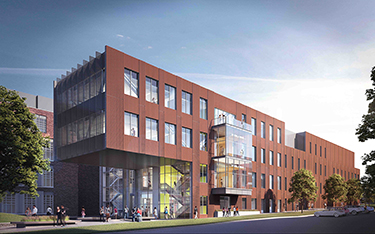|
Subscribe / Renew |
|
|
Contact Us |
|
| ► Subscribe to our Free Weekly Newsletter | |
| home | Welcome, sign in or click here to subscribe. | login |
Architecture & Engineering
| |
 |
April 15, 2021
The evolving building delivery models at higher education institutions
Skanska USA Building

Stewart
|
Colleges and universities are competitive places. From admissions and world-class faculty to research innovations and fundraising, our higher education institutions are building not only for today but also for future generations. The same is true of the buildings that make up these storied institutions.
Here in Washington, recent evolutions to how construction projects are delivered on several campuses are shaping strong, thriving collegiate communities for years to come while also helping ensure maximum benefits to today’s students, faculty, the citizens of our state and our Legislature.
When so many people have a stake in the outcome of a project, we’ve learned over our 75 years that the critical thing to focus on is value. That doesn’t necessarily mean lowest cost, but rather how we deliver the best value to all stakeholders for the money spent. That’s how we truly build what matters.
RESHAPING ROLE
Build-delivery models are rapidly evolving across campuses here in Washington. The thoughtful, innovative, creative and forward-thinking approaches being employed by colleges and universities are helping further the atmosphere of ingenuity for us and our design partners. We are also witnessing a dramatic shift in value-add integrations, where added-value really comes to life in both design-build and integrated project delivery approaches.
However, delivering value does not necessarily look like it used to. Builders have to adapt to a constantly moving goal line by extrapolating new techniques to produce project integrations that not only meet the needs of the community, partners and clients, but also exemplify how each project will positively impact future generations.
Balancing design aesthetic and functionality, maximizing the program with environmental concerns and budgets, and myriad other things that come into play requires builders to step out of their traditional role and embrace a trusted advisor mentality, even when that means potential changes that don’t necessarily benefit the builder.
At Skanska, our trusted advisor relationships have allowed us to work with clients to reshape performance metrics and redefine the value proposition, find progressive and measurable ways to add value, deliver a higher level of thoughtfulness and innovation, and help each institution maximize its return on investment.
BEST VALUE SOLUTIONS
Higher education clients are increasingly migrating to forward-thinking value of design perspectives and build-delivery models which move beyond best-value solutions. Discussions surrounding alignment of core values such as sustainability or fiscal responsibility often saturate the process in interesting ways we can leverage across working groups.
No longer is it enough to offer the best safety track record, glowing references and examples of previous cutting-edge projects. We must instead provide owners with both clear insights and the ability to quantify the enhanced value being delivered.
For our team here at Skanska, three current and recently completed higher education projects highlight not only how we’ve seen this come to life, but also the flexibility that will be needed as the value evolution continues to accelerate.
DESIGN-BUILD; GMP MODEL
The recently completed 82,437-square-foot Plant Sciences Building on the Washington State University campus in Pullman is an example of an extraordinarily successful value-add progressive design-build with a guaranteed maximum price (GMP) agreement in action.
During construction, Skanska and its design partner, LMN Architects, employed an advanced solution for panels of precast exterior brickwork for an attractive and contemporary way to optimize investment on the skin of the building. This allowed for an economical exterior envelope system, which then facilitated the build out of the interior interdisciplinary research spaces.
TRADITIONAL GMP MODEL
At Seattle University, one of Skanska’s longest-tenured higher education clients, we are building the Jim and Janet Sinegal Center for Science and Innovation under a traditional GMP agreement. The center will be the home to future STEM education. Working alongside Seattle University, Mithun Architects and EYP Architecture & Engineering, the Center for Science and Innovation is on track to open for the 2021-22 academic year, and includes construction of a five-story, 111,000-square-foot LEED gold building that will house the biology, chemistry and computer science programs.
Key items that facilitated our success on this project were centered around early engagement and a collaborative approach towards design, budgeting and the constructability review process. Working early and actively in conjunction with reliable and adaptive partners enhances value and provides additional flexibility. This new building will anchor the campus gateway and will advance implementation of the campus master plan.
INTEGRATED DESIGN-BUILD
On the other end of the spectrum from brand new facilities, some universities are reinvesting in aging infrastructure to repurpose and rejuvenate their campuses. With sustainability at the forefront of building upgrades, we have found success reinventing the old.
Partnered with Perkins&Will, the renovation of the 80,000-square-foot Kincaid Hall on the University of Washington campus was a risk-reward partnership with builder, designer, mechanical and electrical trade partners where behaviors set the stage, and where each partner was held accountable for providing best value under the delivery model. Under an integrated design-build delivery approach, the Kincaid Hall renovation replaced aged and outdated building infrastructure and modernized space usage in an environmentally friendly manner to reduce energy consumption and work towards carbon neutrality.
With this reinvestment, we have given a new 50-year lease on life to a 1960s-era building that is core to the campus. Substantial alteration improvements included new windows, a new building-wide ventilation system, plumbing, electrical, seismic upgrades and interior upgrades (including a new MRI suite) to modernize the building and meet the program needs for the Psychology Department and Biology Administration.
The risk-reward model used for Kincaid Hall drove innovation and genuinely pushed the envelope as far as possible in the process of integrations by quantifying a clear line of sight for demonstrating value.
Performance metrics were expected and acted as an incentive for each stakeholder within the greater team to actively collaborative to align on value, while continually evaluating competing needs for limited resources whether financial or otherwise. Where the design-builder boldly questioned the original budget in terms of value, the definition phase duration was nearly doubled and produced the best possible use of our schedule around competing interests and allowed for us to deliver on our promises.
DELIVERING VALUE NOW
Owners will pay for value, but they need to truly see it. That’s why we find the continuing evolution of delivery models to be particularly exciting. Gone are the days of pie in the sky designs and visions of grandeur, only to be forced to cut back to hit a budget. Today, the flexibility to successfully work in a variety of models allows us to deliver on investments because we understand that baselines have changed and will continue to change, and we must take the lead in these new approaches.
At the university level, flexibility, growth with purpose, and finding ways to make a meaningful difference in the lives of our clients, students, and the region, is what will matter most in the years to come, and we are proud to be a part of it.
Tony Stewart is vice president design construction integration at Skanska.
Other Stories:
- Seattle’s U District housing boom: is there room for it?
- Sourcing regional materials for higher ed
- New design requires thoughtful programming
- Early-stage design helps Hermanson with UW center
- How to make master plans that work
- The post-pandemic educational learning curve
- The evolution of campus, a new normal for higher education
- Sustainable student housing building design for higher education



